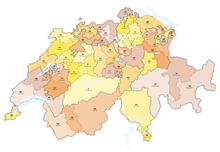1893 Swiss federal election
Federal elections were held in Switzerland on 29 October 1893. The Radical Left narrowly retained its majority in the National Council.[1]
.svg.png) |
|---|
| This article is part of a series on the politics and government of Switzerland |
|
|

The 52 electoral districts
Electoral system
The 147 members of the National Council were elected in 52 single- and multi-member constituencies using a three-round system. Candidates had to receive a majority in the first or second round to be elected; if it went to a third round, only a plurality was required. Voters could cast as many votes as there were seats in their constituency.[2] There was one seat for every 20,000 citizens, with seats allocated to cantons in proportion to their population.[2]
Results
Voter turnout was highest in Schaffhausen (where voting was compulsory) at 91.5% and lowest in Zug at 17.5%.
| Party | Votes | % | Seats | +/– |
|---|---|---|---|---|
| Radical Left | 41.8 | 74 | 0 | |
| Catholic Right | 20.0 | 29 | –6 | |
| Liberal Centre | 16.8 | 27 | +7 | |
| Democratic Group | 10.3 | 16 | +1 | |
| Social Democratic Party | 5.9 | 1 | 0 | |
| Evangelical Right | 4.0 | 0 | –2 | |
| Independents | 1.2 | 0 | 0 | |
| Total | 391,610 | 100 | 147 | 0 |
| Registered voters/turnout | 670,948 | 58.4 | – | – |
| Source: BFS (seats) | ||||
gollark: ```javascript-- is-unnecessary-package/index.jsconst isNpmPackage = require ("is-npm-package")module.exports = package => isNpmPackage(package)```
gollark: At least they don't have `is-number` yet.
gollark: The lots-of-dependencies problem is much worse for Rust than for JS, since Rust is compiled...
gollark: Maybe it's wget http**s**://javathen?
gollark: pacman -S openjdk-8or something.
References
- Elections to the National Council 1848–1917: Distribution of seats by party or political orientation Archived 2015-09-23 at the Wayback Machine BFS
- Dieter Nohlen & Philip Stöver (2010) Elections in Europe: A data handbook, p1886 ISBN 9783832956097
This article is issued from Wikipedia. The text is licensed under Creative Commons - Attribution - Sharealike. Additional terms may apply for the media files.